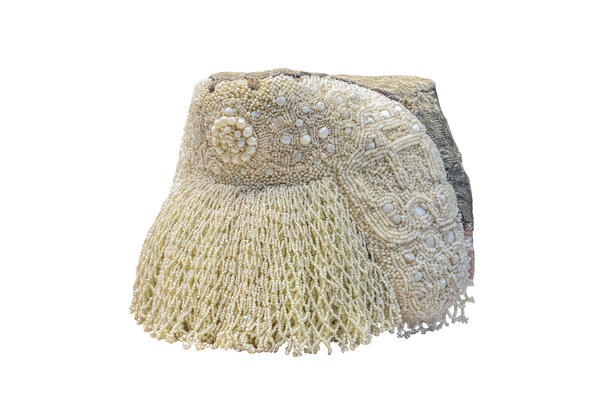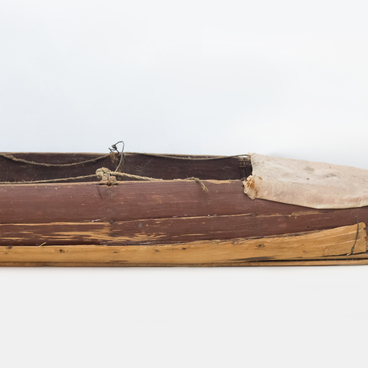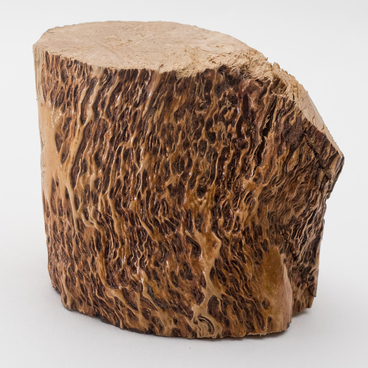The kokoshnik is a festive women’s headdress in the Russian North at the turn of 19th century. This variant is typical for Kargopolsky Uezd of the Olonets Governorate (now, it is the territory of Arkhangelsk Oblast). All types of Kargopol kokoshniks are similar to each other. Most often, they are tight-fitting, firm headdresses. The front part slightly protrudes forward, and an open-work plaiting, a string of beads, goes down. Despite the same shape, these headdresses differ in the design. For example, freshwater pearls and white beads were used in the center of Kargopol region, in addition to mother-of-pearl plates, which can be found in the women’s headdresses of the neighbors. The headdresses were also decorated with passementerie, a braid woven with metal threads.
The kokoshnik from the National Museum of the Republic of Karelia is also made on the firm base. The main part of the headdress is sewn from gold galloon. A plaiting made of silk or metallized gold threads was called a galloon. Such kokoshniks were worn on holidays.
The center of the “ochelye”, the part that covers a forehead, is ornamented with white mother-of-pearl plates laid out in a round rosette. In the back part, the rectangular shield is embroidered with twisted gold metal threads. The flaps that cover ears were called “paushi”. They are decorated with white frshwater pearls, white beads and mother-of-pearl. The ornaments resemble temple rings: coins or compositions of beads, which were used by women in Rus since ancient times.
“The Northern Quadrille” hall presents festive outfits of the indigenous people of Karelia — Karelians and Russians. These are girls', women’s and men’s clothes, which were taken out of chests on the days of big holidays, including weddings.
The pearls for the decoration of kokoshniks were extracted from the shells of freshwater pearl mussels in the rivers of the Russian North. At the heart of a young pearl is a grain of sand trapped inside the shell of a mollusk. For a long time, the pearl mussel could cover the grain of sand with layers of mother-of-pearl. The sizes of river pearls ranged from small grains to items with a diameter from 10 to 14 millimeters. Pearl fishers lifted shells from the bottom of rivers using rafts and wooden tongs. Large pearls were bought by merchants and resold in the capital, and the small ones were used by peasant women in the production of festive headdresses. The Kargopol kokoshniks were famous for their abundant pearl decor.
The kokoshnik from the National Museum of the Republic of Karelia is also made on the firm base. The main part of the headdress is sewn from gold galloon. A plaiting made of silk or metallized gold threads was called a galloon. Such kokoshniks were worn on holidays.
The center of the “ochelye”, the part that covers a forehead, is ornamented with white mother-of-pearl plates laid out in a round rosette. In the back part, the rectangular shield is embroidered with twisted gold metal threads. The flaps that cover ears were called “paushi”. They are decorated with white frshwater pearls, white beads and mother-of-pearl. The ornaments resemble temple rings: coins or compositions of beads, which were used by women in Rus since ancient times.
“The Northern Quadrille” hall presents festive outfits of the indigenous people of Karelia — Karelians and Russians. These are girls', women’s and men’s clothes, which were taken out of chests on the days of big holidays, including weddings.
The pearls for the decoration of kokoshniks were extracted from the shells of freshwater pearl mussels in the rivers of the Russian North. At the heart of a young pearl is a grain of sand trapped inside the shell of a mollusk. For a long time, the pearl mussel could cover the grain of sand with layers of mother-of-pearl. The sizes of river pearls ranged from small grains to items with a diameter from 10 to 14 millimeters. Pearl fishers lifted shells from the bottom of rivers using rafts and wooden tongs. Large pearls were bought by merchants and resold in the capital, and the small ones were used by peasant women in the production of festive headdresses. The Kargopol kokoshniks were famous for their abundant pearl decor.



